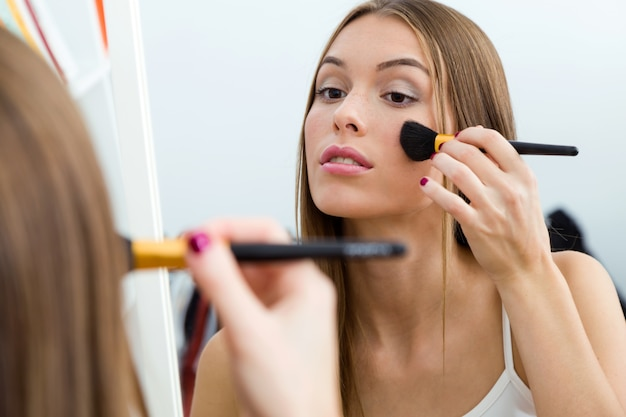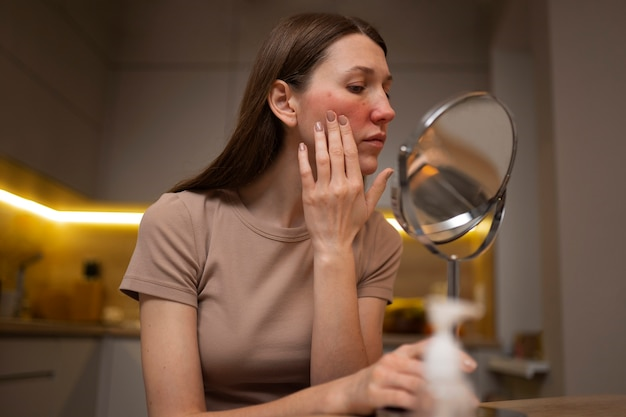Mineral Makeup Myths Debunked: Separating Fact from Fiction
When it comes to cosmetics, the beauty industry is filled with countless trends and products promising miraculous results. Amidst this sea of options, mineral makeup has gained significant popularity over the years. However, like any rising star, it has not been immune to misconceptions and myths. In this article, we will delve into the world of mineral makeup, exploring the common myths that surround it and shedding light on the facts that debunk these misconceptions. By separating fact from fiction, we aim to provide you with a clearer understanding of this beauty phenomenon and help you make more informed decisions about your skincare and makeup routine.

What is Mineral Makeup?
Before we dive into debunking myths, let’s understand what mineral makeup actually is. Mineral makeup is composed of finely ground minerals, such as zinc oxide, titanium dioxide, mica, and iron oxides. These minerals are free from harsh chemicals, synthetic dyes, preservatives, and fragrances that are commonly found in traditional cosmetics.
Debunking Mineral Makeup Myths
Myth: Mineral makeup is not as effective as traditional makeup.
Fact: Mineral makeup can provide excellent coverage and a natural finish. Its finely milled particles adhere well to the skin, giving a flawless appearance without clogging pores or looking heavy.
Myth: Mineral makeup is only suitable for certain skin types.
Fact: Mineral makeup is generally non-comedogenic and works well for a wide range of skin types, including sensitive, acne-prone, and oily skin. It allows the skin to breathe and can be easily customized for various coverage levels.
Myth: Mineral makeup lacks variety in shades.
Fact: Mineral makeup now comes in an extensive range of shades to suit different skin tones. Many brands offer customizable options that allow individuals to blend shades to achieve a perfect match.
Benefits of Mineral Makeup
Mineral makeup offers several advantaged including;
Natural Ingredients: One of the major benefits of mineral makeup is the absence of harsh chemicals, making it a healthier option for your skin. The use of natural ingredients can reduce the risk of irritation, breakouts, and allergic reactions.
Sun Protection: Mineral makeup often contains zinc oxide and titanium dioxide, which act as physical sunscreens. These minerals provide broad-spectrum protection against harmful UVA and UVB rays, helping to prevent premature aging and sun damage.
Longevity: Mineral makeup has excellent staying power due to its lightweight formula and high pigmentation. It can withstand heat, humidity, and sweat, making it ideal for long-lasting wear, even in challenging conditions.
Facts about Mineral Makeup
Some common and beneficial facts about mineral makeup are;
-
- Mineral makeup can be used for various purposes. It not only offers coverage for imperfections but can also be used as an eyeshadow, blush, or lip color. This versatility makes it a convenient and multifunctional choice.
-
- The absence of synthetic ingredients in mineral makeup makes it less likely to cause skin irritation or exacerbate existing skin conditions. It is often recommended by dermatologists for individuals with sensitive or reactive skin.
-
- Mineral makeup provides a natural, luminous finish that enhances the skin’s appearance without looking heavy or cakey. It allows the skin’s natural radiance to shine through, giving a healthy and youthful glow.
Is Mineral Makeup Safe?
Mineral makeup is generally considered safe for use. However, it is important to choose reputable brands that prioritize quality and transparency. Look for products that are free from potentially harmful ingredients and undergo rigorous testing. It’s also advisable to perform patch tests before trying any new cosmetic product to ensure compatibility with your skin.
Common Misconceptions about Mineral Makeup
Misconception: Mineral makeup is difficult to choose and apply correctly
Fact: Choosing mineral makeup involves considering your skin type, undertones, and desired coverage. Look for reputable brands that offer shade-matching tools and consult beauty experts for guidance. Applying mineral makeup can be simple and requires basic techniques such as using a brush or sponge to blend the product evenly on the skin.
Misconception: Mineral makeup lacks staying power
Fact: Mineral makeup often has excellent staying power due to its lightweight yet pigmented formula. It can withstand heat, humidity, and sweat, making it ideal for long-lasting wear throughout the day.
How to Choose Mineral Makeup
-
- Determine whether you have dry, oily, combination, or sensitive skin. Look for mineral makeup formulations that cater to your specific skin type to ensure optimal results and comfort.
-
- Read the product labels and avoid mineral makeup containing potential irritants or allergens. Look for ingredients like zinc oxide, titanium dioxide, mica, and iron oxides, and ensure they are free from harmful additives.
-
- Research and choose established brands known for their commitment to quality and transparency. Read customer reviews and look for certifications or endorsements from dermatologists or skincare professionals.
How to Apply Mineral Makeup
-
- Cleanse and moisturize your skin before applying mineral makeup. This helps create a smooth canvas for better product application.
-
- Opt for a brush or sponge specifically designed for mineral makeup application. These tools help ensure even distribution and seamless blending.
-
- Start with a small amount of product and build coverage gradually. This approach allows you to achieve the desired level of coverage without overwhelming the skin.
-
- Take your time to blend the product thoroughly, ensuring an even and natural-looking finish. Pay attention to areas that require more coverage, such as blemishes or redness.
Ingredients in Mineral Makeup
Mineral makeup typically contains natural ingredients that offer benefits for the skin. Some common ingredients found in mineral makeup include:
Zinc Oxide and Titanium Dioxide: These minerals provide broad-spectrum sun protection, shielding the skin from harmful UVA and UVB rays.
Mica: Gives a natural luminosity and reflects light, providing a healthy glow to the skin.
Iron Oxides: Provide pigment and contribute to the color range available in mineral makeup.
How to Apply Mineral Makeup for a Natural Look
-
- Cleanse and moisturize your skin prior to applying mineral makeup. This helps create a smooth canvas for better product application.
-
- Opt for a brush or sponge specifically designed for mineral makeup application. These tools help ensure even distribution and seamless blending.
-
- Begin with a small amount of product and gradually build coverage as needed. This approach allows for a more natural and lightweight look, avoiding a heavy or cakey appearance.
-
- Take your time to blend the product thoroughly, paying attention to areas that require more coverage. This helps achieve a seamless and natural finish.
Mineral Makeup vs. Traditional Makeup
Mineral makeup and traditional makeup are two distinct categories that offer different options for enhancing one’s appearance. Mineral makeup is composed of finely ground minerals, free from harsh chemicals and synthetic additives, making it a popular choice for those seeking a natural and gentle alternative. It typically provides buildable coverage, a lightweight finish, and the potential benefits of sun protection. On the other hand, traditional makeup encompasses a wider range of products with various formulations and ingredients, including minerals but also synthetic additives. It offers a greater variety of coverage options, finishes, and customization, catering to different preferences and makeup styles. Ultimately, the choice between mineral makeup and traditional makeup depends on individual preferences, skin type, and desired outcomes.
In conclusion, it is essential to separate fact from fiction when it comes to mineral makeup. Despite the numerous misconceptions and myths, this beauty phenomenon has proven itself as a worthy contender in the cosmetics industry. Its natural ingredients, light textures, and potential benefits for various skin types make it an attractive choice for those seeking a healthier and more radiant appearance.
We have debunked some of the most common myths surrounding mineral makeup, such as the notion that it lacks coverage or is not suitable for sensitive skin. By exploring the scientific evidence and understanding the true nature of mineral makeup, we can confidently dismiss these misconceptions.
As consumers, it is crucial to stay informed and make choices based on reliable information. By embracing the facts about mineral makeup, we can make better decisions about the products we use and the impact they have on our skin and overall well-being.
So, the next time you hear someone dismiss mineral makeup, remember to separate fact from fiction. With its natural ingredients, potential benefits, and proven performance, mineral makeup has earned its rightful place in the world of cosmetics. Embrace its beauty, enjoy its benefits, and let the myths surrounding it fade away, leaving you with a radiant, confident, and well-informed approach to your beauty routine.




